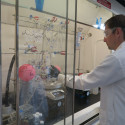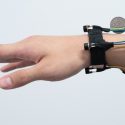‘Rewiring’ metabolism in insulin-producing cells may aid Type 2 diabetes treatment
Researchers have discovered a previously unknown way that pancreatic cells decide how much insulin to secrete. It could provide a promising new target to develop drugs for boosting insulin production in people with Type 2 diabetes.
In a pair of papers recently published in Cell Metabolism, scientists from the University of Wisconsin–Madison and their colleagues point to an overlooked enzyme known as pyruvate kinase as the primary way pancreatic beta cells sense sugar levels and release the appropriate amount of insulin.
From several proof-of-concept experiments in rodents and on human pancreatic cells, the team found that drugs stimulating pyruvate kinase not only increase the secretion of insulin but have other metabolically protective effects in the liver, muscle and red blood cells. The findings suggest that activating pyruvate kinase could be a new way to increase insulin secretion to counter Type 2 diabetes, but more research would be required before any new treatments were available.
“Too much insulin can lower blood sugar to dangerous levels, and too little insulin can lead to diabetes,” says Matthew Merrins, a professor of medicine at the UW School of Medicine and Public Health who led the work. “The question we’re asking here is: How do nutrients like glucose and amino acids turn on beta cells in the pancreas to release just the right amount of insulin?”
The work was accomplished by carefully dissecting the paradoxical timing of key biochemical events in the prevailing understanding of how pancreatic beta cells respond to nutrients in the blood. The researchers point to a new, richer model to understand how this important process is controlled that resolves these inconsistencies.
For decades, scientists believed that mitochondria, the energy generators in cells, initiated insulin secretion. It was a natural explanation, because mitochondria produce the high-energy molecule ATP, in the process depleting ATP’s low-energy version, ADP. The drop in ADP stimulates calcium — the ultimate trigger to release stored insulin.
But the timing didn’t make sense. Mitochondria are most active after insulin secretion has already begun, not before. Plus, mitochondria would stall out before exhausting enough ADP to trigger insulin secretion.
A clue to solving these apparent paradoxes came from studies in the 1980s on heart muscle cells. At the time, scientists found that the enzyme pyruvate kinase — which converts sugar into energy, independently of mitochondria — could also severely deplete ADP. This process happens near ADP-sensing proteins involved in insulin release in the pancreas. Maybe, Merrins’ team thought, the pancreas took advantage of this proximity to fine-tune the release of insulin.
In initial experiments, the researchers supplied sugar and ADP to sections of pancreatic cells containing pyruvate kinase. The enzyme gobbled up both components, depleting ADP. Because pyruvate kinase was located near the ADP-sensing protein that triggers insulin secretion, it had a big effect.
“That’s one of the important concepts in our paper: the location of metabolism is critical to its function,” says Merrins.
Using mouse and human pancreatic islets, the clusters of cells that release insulin, the researchers tried stimulating pyruvate kinase activity. Drugs that activate the enzyme quadrupled the release of insulin, but only when there was enough sugar around — a sign that pyruvate kinase can’t be forced to release too much insulin.
“Pyruvate kinase doesn’t change how much fuel comes into the cell, it just changes how that fuel is used,” says Merrins. “Drugs that active pyruvate kinase strongly boost insulin secretion without causing too much insulin release that can lead to hypoglycemia.”
In all, they discovered evidence of a more complex way in which pancreatic beta cells decide when and how much insulin to release, akin to a two-cycle engine. In the first cycle, blood sugar gets processed by pyruvate kinase, depleting ADP. Mitochondria keep the process going by feeding pyruvate kinase even more material, which causes ADP levels to crash, ultimately stimulating enough calcium entry into the cell to release insulin.
In the second cycle, mitochondria switch from feeding pyruvate kinase with material to producing the high-energy molecule ATP, which is needed to fully release insulin. Then the process resets.
In the companion study, led by Merrins’ colleagues at Yale University, the researchers examined how pyruvate kinase activators affected metabolism in healthy and obese rats. In a series of experiments, they found that activating pyruvate kinase increased both insulin secretion and insulin sensitivity while improving sugar metabolism in liver and red blood cells. Such treatments could be helpful for people with Type 2 diabetes, who don’t produce enough insulin and have dysfunctional sugar metabolism as a result.
“The therapeutic idea here is we could rewire metabolism to more efficiently trigger insulin secretion while improving the function of other organs at the same time,” says Merrins.
This work was supported in part by the National Institutes of Health (grants R01DK092606, R01DK110181, K08DK080142, UL1RR-0024139, P30DK045735, K01DK101683, R01DK113103, R21AG050135, R01AG062328, F32DK116542, T32AG000213, T32DK007665) and the Health Resources and Services Administration (grant T32HP10010).



